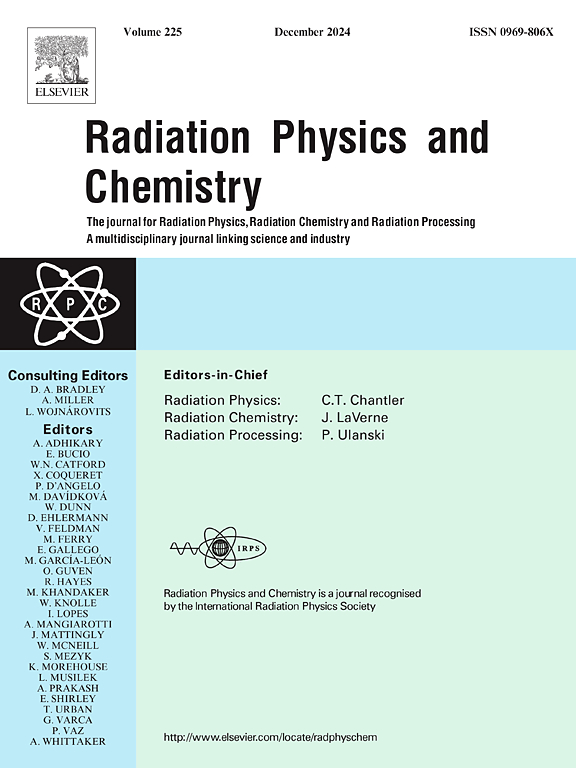评估起搏器对乳腺癌放疗的剂量学影响:蒙特卡洛研究
IF 2.8
3区 物理与天体物理
Q3 CHEMISTRY, PHYSICAL
引用次数: 0
摘要
背景/介绍人口老龄化和不健康的生活习惯增加了癌症和心血管疾病的发病率,往往需要植入对辐射敏感的起搏器。三维适形放疗是治疗乳腺癌的常用方法;然而,超过2gy的吸收剂量可能导致起搏器故障。目的探讨起搏器对乳腺癌放疗的影响。方法本研究使用MCNP 6.3粒子传输代码在LINAC Versa中模拟6 MV乳腺癌放疗,在Blender中模拟起搏器并将其植入ICRP Publication 145中的女性参考体。结果对治疗容积附近脏器进行分析,结果表明心脏和同侧肺的吸收剂量分别增加0.61%和0.66%,而在乳腺规定剂量为50 Gy时,同侧起搏器吸收23.49 Gy。当使用基于mlc的屏蔽时,起搏器剂量降至1.15 Gy,乳房剂量降低18.89%。将起搏器移至对侧乳房后,其剂量进一步降低至0.44 Gy。局部剂量分布与起搏器无显著差异。结论起搏器移位和基于mlc的屏蔽是降低装置吸收剂量的有效策略。本文章由计算机程序翻译,如有差异,请以英文原文为准。
Evaluation of the dosimetric influence of a pacemaker on breast cancer radiotherapy: A Monte Carlo study
Background/introduction
Population aging and unhealthy lifestyle habits increase the incidence of cancer and cardiovascular diseases, often necessitating the implantation of pacemakers, which are sensitive to radiation. 3D conformal radiotherapy is a common approach for treating breast cancer; however, absorbed doses above 2 Gy may cause pacemaker malfunctions.
Purpose
The aim of this study is to evaluate the influence of a pacemaker on breast cancer radiotherapy.
Methods
This study used the MCNP 6.3 particle transport code to simulate a 6 MV breast cancer radiotherapy in a LINAC Versa, modelling a pacemaker in Blender and implanting it in the female reference phantom from ICRP Publication 145.
Results
Analysing the organs adjacent to the treatment volume, results indicated that the heart and ipsilateral lung received an increase of 0.61 % and 0.66 % in absorbed dose, respectively, while the ipsilateral pacemaker absorbed 23.49 Gy for a prescribed breast dose of 50 Gy. When using MLC-based shielding, the pacemaker dose decreased to 1.15 Gy, with a 18.89 % reduction in breast dose. Relocating the pacemaker to the contralateral breast further reduced its dose to 0.44 Gy. No significant differences were observed in local dose distribution with the pacemaker.
Conclusion
Pacemaker relocation and MLC-based shielding are effective strategies to reduce the dose absorbed by the device.
求助全文
通过发布文献求助,成功后即可免费获取论文全文。
去求助
来源期刊

Radiation Physics and Chemistry
化学-核科学技术
CiteScore
5.60
自引率
17.20%
发文量
574
审稿时长
12 weeks
期刊介绍:
Radiation Physics and Chemistry is a multidisciplinary journal that provides a medium for publication of substantial and original papers, reviews, and short communications which focus on research and developments involving ionizing radiation in radiation physics, radiation chemistry and radiation processing.
The journal aims to publish papers with significance to an international audience, containing substantial novelty and scientific impact. The Editors reserve the rights to reject, with or without external review, papers that do not meet these criteria. This could include papers that are very similar to previous publications, only with changed target substrates, employed materials, analyzed sites and experimental methods, report results without presenting new insights and/or hypothesis testing, or do not focus on the radiation effects.
 求助内容:
求助内容: 应助结果提醒方式:
应助结果提醒方式:


